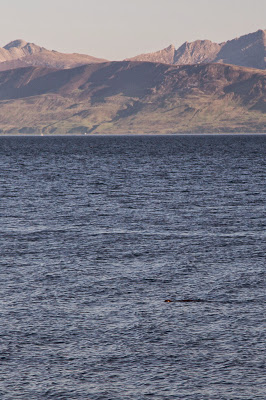
As we approached Gourock, we came to
McInroy's Point, which is the terminus for the
Western Ferries route to Hunter's Quay on the Cowal peninsula. This is the MV Sound of Shuna and she has three sister ships: MV Sound of Scarba, MV Sound of Sanda and MV Sound of Scalpay. If you plan to use this crossing you can get discount tickets in
Paul's Food and Wine shop at 94, Shore St, Gourock.
These ferries operate a very quick turn around so we stopped where the captain could see us. He came out onto the flying bridge and waved us on. We got a good boost from the ferry's thrusters, which were holding her at the jetty.

We cruised past Gourock esplanade enjoying views over the Firth of Clyde to the Cowal Hills and the Holy Loch.

We turned south round
Kempock Point. We passed under the once grand Gourock railway terminus which once transferred thousands of Glaswegians to steamers to take them "doon the watter" to the Clyde resorts where they spent their holidays.

We found two CalMac ferries "resting" between assignments. MV Jupiter normally covers the Gourock to Dunoon route but her sister ship MV Saturn is covering that service at the moment. In the summer Saturn provides extra crossings from Ardrossan to Brodick. I last saw MV Loch Alaine on the Eriskay Barra route.

As we left Gourock MV Saturn was approaching her berth. We could just make out the MV Seabus, leaving Kilcreggan bound for Gourock. She is a passenger ferry operated by Clyde Marine Sevices on the
Gourock Kilcreggan Helensburgh route.
It sounds like Gourock is a busy ferry terminal. Well it is, but it is a shadow of its former self. Scores of competing ferries raced each other to the piers that had sprung up all round the Clyde. A sea kayaker would have needed very sharp eyes in those days. Even today, we chose to cross the various ferry routes near their piers and jetties.




















































